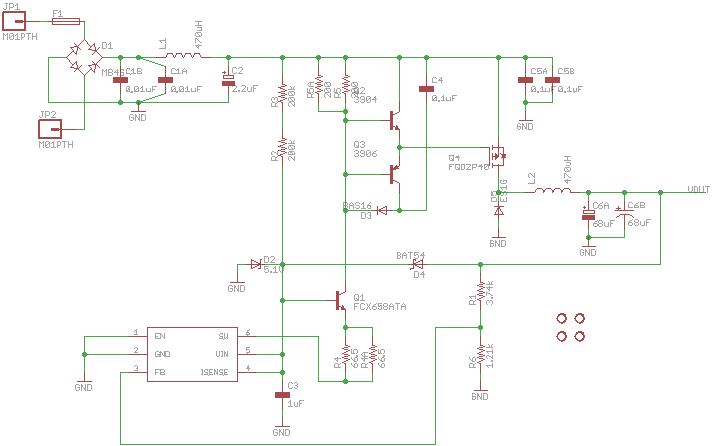Hello TI --
I'm interested in building an AC supply for a microcontroller/WiFi combo, with 120VAC input and 5VDC output. To save on cost and space, I liked the idea of a transformer-less design, and came across this application note for the TI TPS64203. I've since attempted to build this circuit, but now, I'm having some trouble getting it to run without throwing sparks.
Thus far, I'm made the following observations:
1. Immediately after assembly, I provided power to the circuit, and measured an output voltage of 1.68V across a load of 250 ohm. I increased the load to 1kohm, and found that the output voltage was the same. I measured the voltage out of the Rectifier bridge to be 160V (using a Multimeter), and the voltage across the D2 diode to be 4.6V. I then noticed that I had the accidentally switched the R1 and R6 resistors. Based on my calculations, the voltage on the FB pin (on the TPS64203) should be around 1.25V when the the output voltage is 5V and the proper resistors are used. Instead, with an output of 1.68V, and the incorrect resistor placement, this caused the voltage at the FB pin to be slightly greater than 1.25V, and thus, the drive circuit was never turned on!
2. In my second attempt, I placed the R1 and R6 in their proper places, and turned on the circuit. This is when the L1 inductor exploded. I had assumed that an inductor rated at 100mA at the high voltage input would be sufficient, but I guess I was wrong. Fortunately, I had a handful of the 1A rated inductors used for the output filter. Realizing this was certainly overkill, I dead-bugged one of these big guys, and replaced the fried L1 part.
3. In my final attempt, with the new inductor, I switched on the power, and witnessed another spark. This time, the spark came from the TPS64203 and the BAT54 (D4) diode. There were black soot marks extending between the two ICs, and it appears that the diode had split through the top of the IC. I'm not sure which IC is to blame here, so I'm hesitant to try again.
Now that I've got you up to speed on what I've observed, I'd like to talk a bit about my part selection for building this power supply. As you may have already suspected, I'm no expert with building power supplies and working with semi-conductor devices, and thus, in my first iteration, I wanted to select parts that would be overkill for this application. Furthermore, it can be seen in the schematic and board layout that I've included space for multiple packages for certain parts (C1, C5, C6, R4, R5) that I was unsure of. In the testing described above, I initially built the board with the heftier parts (if I had a choice), and my intention was to test with the smaller, cheaper parts once the supply was working. I've also included a link to a Google document, containing my Bill of Materials. Note that the items highlighted in Red are the "less hefty" parts that were not utilized in the testing mentioned previously. Follow the links to the DigiKey page for each item -- this is very helpful for locating datasheets for each part.
At this juncture, I'm not really sure how to proceed. One concern that I have is that the traces around pins 1-3 on the TPS64203 are really close together. I'm concerned that this may have allowed a short, but I can't be sure. I probed all of these pin with a multimeter, and there seemed to be no shorts. Does anyone have any suggestions? Are there any more measurements that I can take to provide some additional insight? I have a board mounted oscilloscope, so I can take detailed measurements; however, the inputs are limited to 20V. Therefore, I'm limited to monitoring certain portions of the circuit.
On another note, I'm finding that the FQD2P40 MOSFET has been discontinued, and it will be more and more difficult to obtain. Fairchild suggests a replacement part for this, but I'm not sure if it will be a perfect drop in replacement. Does anyone have an input regarding this? Secondly, if things don't work out with this application note, does anyone have any similar circuits that they've built that they wouldn't mind sharing? Something with a BOM would be preferable.
Thanks very much for any help!
Application Note: "A low cost, non-isolated AC/DC buck converter with no transformer"
http://www.ti.com/lit/an/slyt391/slyt391.pdf
Bill of Materials - BOM:
https://docs.google.com/spreadsheet/ccc?key=0Am2etFM3DynNdExNNDNkMkFMcDJpUllmdjM4SlpraHc
Eagle Files:
Eagle Files (images) :



